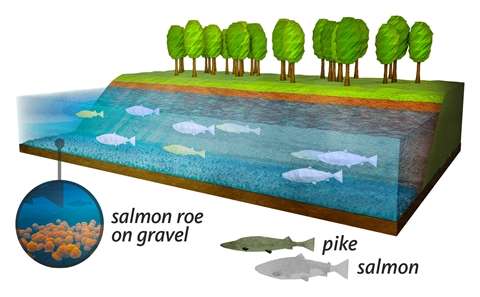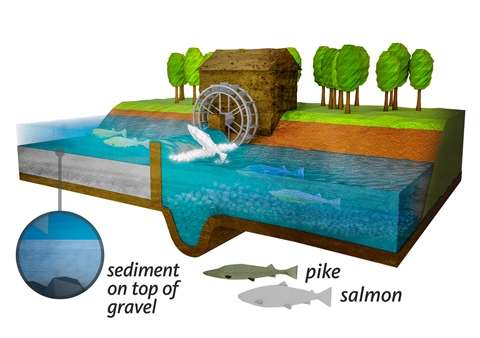Medieval water power initiated the collapse of salmon stocks

Salmon largely disappeared from the Netherlands due to the construction of water mills, ecologists from Radboud University conclude (Scientific Reports, 20 July). The construction of water mills caused the destruction of the gravel beds in streams, making them unsuitable for salmon to spawn. Whereas it was previously thought that water contamination was the most likely explanation, archival research demonstrates that salmon stocks had already dwindled prior to the invention of the steam engine.
Salmon have always been cherished and are now a priority for nature conservation. Rob Lenders from Radboud University and his team carried out archival research, as part of which they looked at numbers and prices stated in sources from north-western Europe as of 1260. These data included leases, permits, reports from fish auctions, and the Domesday Book. They also connected a large variety of existing, small datasets.
Half ecologist, half historian
"This project turned me into a half historian, as I spent more time rummaging through archives than in the field. All that we observed was decline; never was there a period that showed any increase. I estimate that at the beginning of 1900, 99 % of the numbers from the middle of the thirteenth century had disappeared.
A tale that keeps cropping up since the seventeenth century, provides anecdotal evidence for the abundance of salmon in previous times. The story goes that servants would state in their contracts that they did not wish to eat salmon too often. That said, I haven't found evidence that backs this up. I've got a good bottle of wine waiting for the first person who can provide me with such a contract."
Roel Lauwerier from the Cultural Heritage Agency of the Netherlands corroborated Lenders' archival findings with data from archaeological sites at which fish bones were uncovered. He says, "The Middle Ages shows a sudden change in terms of proportions: the number of locations at which remains of pike are found increase compared to the number at which salmon remains are uncovered."

Cause of the decline in salmon stocks
Overfishing of salmon to feed a growing population cannot explain the decline, says Lenders. "Data from the year 1311 onwards shows that the salmon stock remained steady in Scotland, a country in which fishing was taking place on an equal scale to other areas.
We then looked at what changed in the water systems. As of the year 1000, you can notice the widespread construction of water mills, which numbered the tens of thousands once they were all completed. Water mills were also built in Scotland, but there were fewer of them and they had a different design that had a far lesser impact on the riverbeds."
Lenders identified a clear correlation between the construction of water mills and the decline in salmon stocks. Water mills need dams, obstructing the salmon that are swimming upstream to lay eggs. Thanks to the salmon's excellent jumping abilities, a number of animals can complete the arduous journey to the spawning area – only to end up in an area that is unfit for spawning.
Lenders continues, "As the water mills and associated dams and pools bring the flow of the river to a halt, this causes a great deal more sediment to settle upstream. The gravel beds that the salmon need to lay eggs have disappeared under a thick layer of sand and silt."
Consequences for the ecosystem
The decline in salmon stocks has had a huge ecological impact. Lenders explains, "The hundreds of tonnes of salmon that once swam up the streams every year carried nutrients from the ocean into the mountains. The decline in bears, wolves and eagles could be explained by the absence of salmon."
The future
Lenders concludes, "Conservation programmes aimed at the recovery of the salmon population will have little effect, regardless of how clean the water is. The spawning areas have been permanently changed by the water mill damming. Even if you remove the mills and dams, this effect will endure for centuries due to the steps in the riverbed that have been formed. It would be an extremely costly process to remedy this, assuming that that is even possible."
More information: H. J. R. Lenders et al. Historical rise of waterpower initiated the collapse of salmon stocks, Scientific Reports (2016). DOI: 10.1038/srep29269
Journal information: Scientific Reports
Provided by Radboud University


















